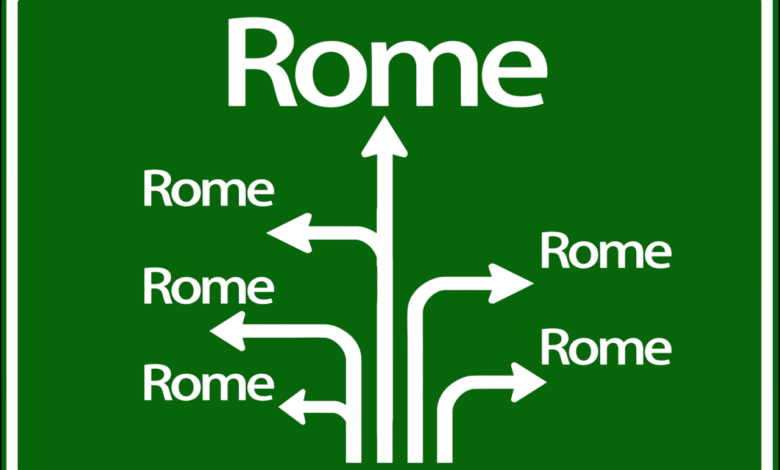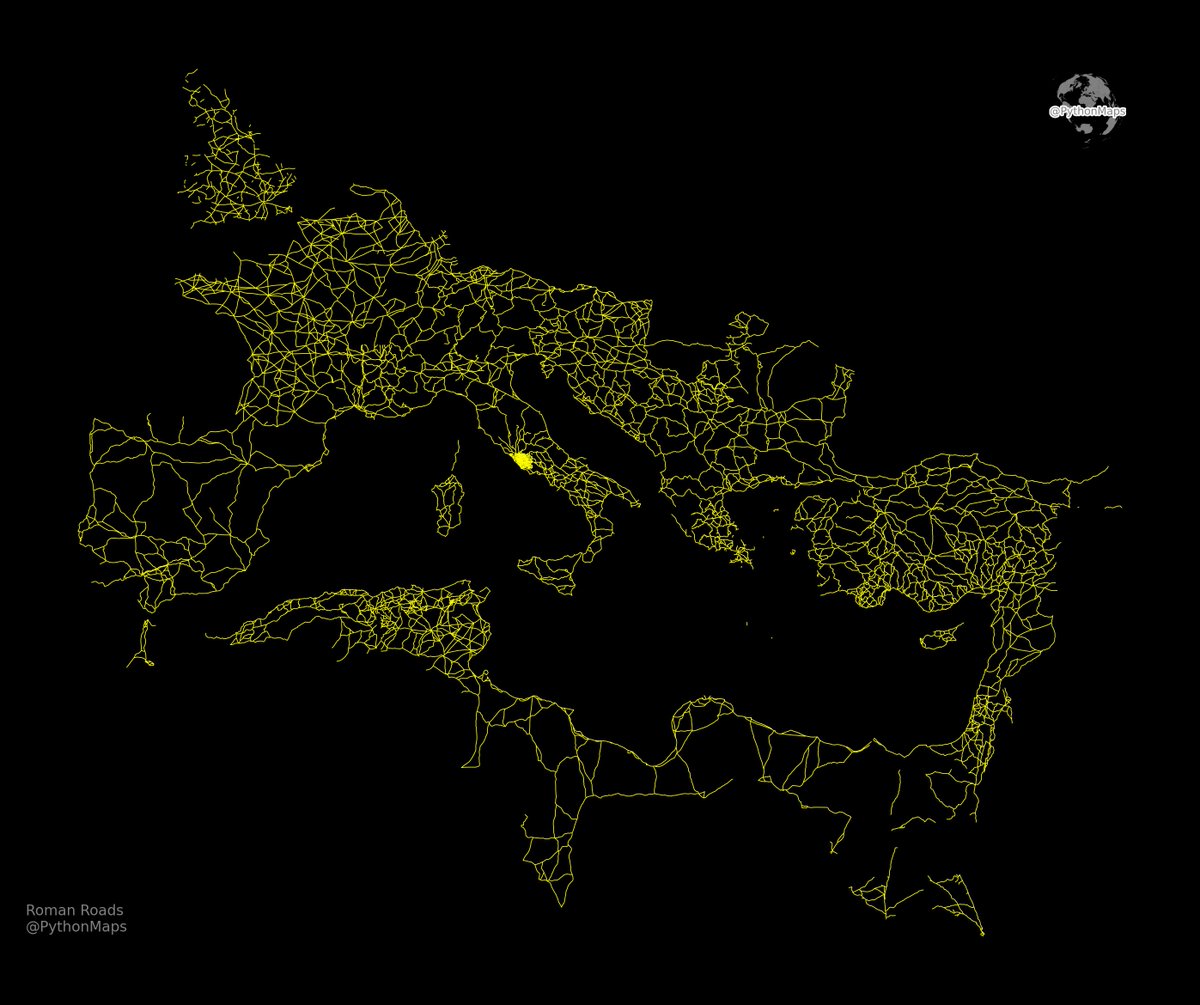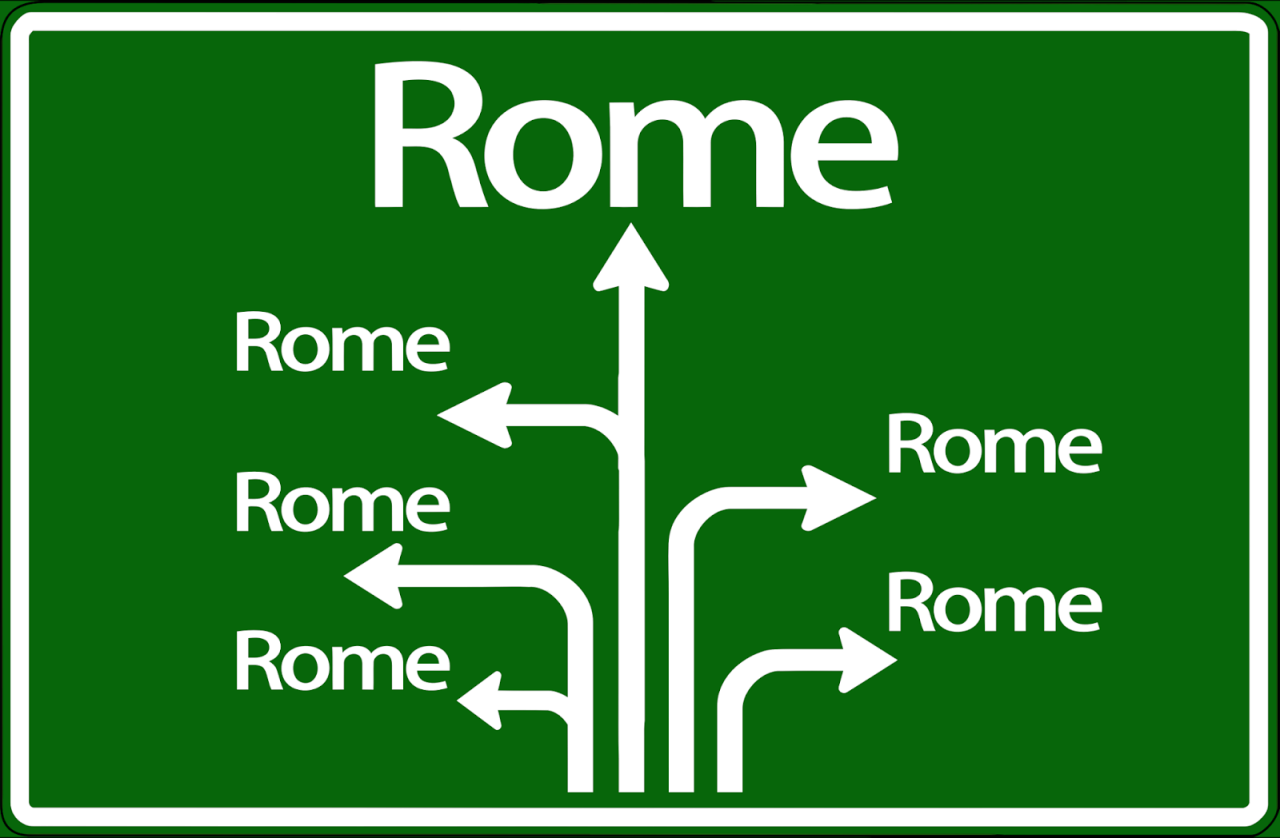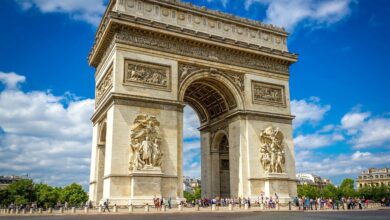
All Roads Lead to Rome A Journey Through Time
All roads lead to Rome. This ancient adage, echoing through history, speaks to the interconnectedness of paths and destinations. It invites us to consider the myriad routes we take, whether physical journeys through landscapes or metaphorical pathways in life. From the meticulously planned Roman road network to modern career aspirations, this phrase has resonated with individuals and societies for centuries, prompting reflections on the journey itself and the eventual destination.
The historical context of the saying reveals the impressive infrastructure of the Roman Empire. This extensive network of roads facilitated trade, communication, and the expansion of the empire. But what does this ancient wisdom mean in our contemporary world? What are the metaphorical interpretations, and how does this principle apply to modern situations, from personal goals to global trends?
Historical Context
The phrase “all roads lead to Rome” encapsulates more than just a literal description of ancient Roman infrastructure. It symbolizes the empire’s vast influence and the interconnectedness it fostered across the Mediterranean world. This interconnectedness wasn’t merely physical; it extended to political, economic, and cultural spheres, shaping the ancient world in profound ways.The pervasiveness of Roman roads was a key factor in the empire’s success.
More than mere paths, they were arteries of power, facilitating trade, communication, and military movement. The ease of travel they provided fostered the exchange of ideas, goods, and people, creating a unified cultural landscape within the vast Roman realm.
Roman Road System Overview
The Roman road system was a marvel of engineering. Constructed primarily of stone, these roads were meticulously planned and built to withstand the rigors of time and use. They were crucial for the administration and defense of the empire, allowing swift troop deployment and the rapid transport of supplies. Their design, incorporating features like drainage systems and well-defined alignments, ensured durability and practicality.
Significance of Roman Infrastructure
Rome’s remarkable road network significantly impacted the social and political fabric of the ancient world. The ability to swiftly traverse the empire facilitated the collection of taxes, the deployment of legions, and the administration of distant provinces. The smooth flow of trade along these roads boosted economic activity, connecting disparate regions and fostering economic interdependence. This interconnectedness also contributed to the spread of Roman culture, law, and language, fostering a sense of shared identity across a vast expanse.
Comparison with Other Ancient Road Systems
| Feature | Roman Roads | Carthaginian Roads | Persian Roads | Greek Roads |
|---|---|---|---|---|
| Materials | Stone, gravel, and sometimes concrete | Stone and compacted earth | Earth, stone, and sometimes paved sections | Stone, gravel, and packed earth |
| Design | Precise alignment, drainage systems, durable construction | Generally less sophisticated alignment, less emphasis on drainage | Well-maintained, strategically placed stations, paved sections | Rudimentary alignment, often following natural terrain |
| Purpose | Military, trade, communication, administration | Military and trade | Military and imperial communication | Trade, communication, and local travel |
| Extent | Extensive network throughout the empire | Extensive network within Carthage’s territories | Extensive network throughout the Persian Empire | Less extensive than Roman or Persian, primarily focused on specific regions |
The table above provides a concise comparison of Roman road systems with those of other prominent ancient civilizations in the Mediterranean. Notice the Roman emphasis on meticulous design and comprehensive construction, which contributed to their durability and effectiveness over time.
Routes and Networks Connecting to Rome
A multitude of routes converged on Rome, forming a complex network that connected every corner of the empire. The Via Appia, for example, a significant artery running south from Rome, facilitated trade and communication with the southern Italian peninsula. Other crucial routes, like the Via Flaminia and the Via Emilia, linked Rome to the north. These routes, along with countless smaller paths, formed a sophisticated network that facilitated movement and interaction throughout the Roman world.
Societal and Political Implications
The extensive road system fundamentally altered societal and political structures within the Roman Empire. The ease of travel fostered the exchange of ideas, the spread of Roman culture, and the creation of a sense of shared identity. The ability to swiftly deploy troops and administer distant provinces was crucial for maintaining political control over the vast empire. The interconnectedness fostered by the roads created a degree of unity and stability that proved vital for the empire’s longevity.
Metaphorical Interpretations
The adage “all roads lead to Rome” transcends its literal historical context. It’s a powerful metaphor, implying a unifying destination or goal, regardless of the path taken. This concept has resonated across cultures and time periods, shaping interpretations in various fields. It speaks to the human desire for purpose and the belief that different approaches can ultimately converge on a common objective.The phrase offers a profound insight into human nature’s quest for meaning and fulfillment.
It suggests that while the journey might be unique and challenging, the ultimate destination, if pursued with dedication, is attainable. This metaphorical meaning is adaptable to diverse contexts, from personal goals to global aspirations.
Applying the Metaphor to Goals and Paths
The metaphor “all roads lead to Rome” is a timeless expression about the convergence of different paths toward a single destination. This applies to numerous aspects of life, such as personal goals and professional aspirations. For example, students pursuing higher education might take diverse routes—some might choose traditional universities, while others might opt for vocational training or apprenticeships.
Yet, the ultimate goal – gaining knowledge and skills to achieve professional success – remains the same.
The saying “all roads lead to Rome” holds true in many aspects of life, and sometimes, even a small, focused adventure like a bite size sailing experience can feel like a journey towards something bigger. Embarking on a bite size sailing experience might not be the same as exploring the grand sweep of the Roman Empire, but the personal growth and discovery are similar.
It’s all about the journey, and in the end, all roads lead to a unique and rewarding destination.
Applying the Metaphor to Modern Situations
In today’s interconnected world, the metaphor’s relevance remains strong. Consider the diverse paths individuals might take to achieve financial stability. Some might pursue careers in finance, while others might opt for entrepreneurship or investing. Despite these differences, the common goal – achieving financial security – unites them.
Historical Interpretations
The concept of “all roads lead to Rome” has been interpreted in various ways throughout history. Early interpretations likely focused on Rome’s political and economic dominance, its central position in the Roman Empire, and the concept of Rome as a unifying force. Over time, as empires rose and fell, the metaphor shifted to represent the convergence of different approaches toward shared goals.
The saying “all roads lead to Rome” suggests a single destination, no matter the starting point. But even with a seemingly inevitable endpoint, sometimes things change. Like the recent news that the Aker Yards name is going away aker yards name goes away. This shift, while seemingly disruptive, just underscores the idea that while the path may be altered, the underlying principle of reaching a goal still applies.
All roads, even those that seem to be detours, still ultimately lead to Rome, in a way.
Cultural Interpretations Across Time
| Time Period | Culture | Interpretation |
|---|---|---|
| Ancient Rome | Roman | Rome as the ultimate destination, reflecting its power and influence. |
| Medieval Europe | Various | A unifying force, potentially religious or political, converging on a common goal. |
| Renaissance | European | A pursuit of knowledge and enlightenment, often seen as a convergence of philosophical and scientific ideas. |
| Modern Era | Global | A broad concept of different paths leading to success, personal fulfillment, or societal advancement. |
Modern Applications
The adage “all roads lead to Rome” originally symbolized the convergence of various paths toward a single, significant destination. This ancient metaphor, deeply rooted in the Roman Empire’s vast infrastructure and central authority, continues to resonate in modern contexts, though its meaning often shifts and adapts. Its application extends beyond mere physical travel, encompassing various aspects of life, from personal development to marketing strategies.This adaptability highlights the enduring power of the metaphor.
It underscores the idea that, regardless of the initial path chosen, numerous seemingly divergent approaches can ultimately lead to similar outcomes or goals. Understanding these modern applications reveals the enduring relevance of this time-tested concept.
Modern Interpretations of “All Roads Lead to Rome”
The phrase’s power lies in its adaptability. Instead of a single physical city, “Rome” can represent a variety of destinations. This could be a desired career, a particular life goal, or even a successful business outcome. The concept suggests that multiple avenues can contribute to the same ultimate achievement.
Personal Development and Career Paths
The idea that “all roads lead to Rome” applies strongly to personal development and career choices. Individuals might choose different educational paths, career specializations, or professional networks, yet the ultimate goal of career success might remain consistent. While the journeys may differ in route and duration, the destination—professional fulfillment and achievement—can remain the same. Different educational tracks, from specialized training to general degrees, can all ultimately contribute to a desired professional niche.
Marketing and Advertising
Businesses often utilize this concept in their marketing campaigns. A company might advertise a wide range of products or services, implying that all of them ultimately lead to the same desired consumer satisfaction or financial benefit. The implication is that the company is offering diverse ways to reach a common goal.
Comparison of Original and Modern Meanings
| Aspect | Original Meaning (Roman Empire) | Modern Applications |
|---|---|---|
| Destination | The physical city of Rome | A desired career, a specific goal, a successful business outcome |
| Paths | Physical roads converging on Rome | Different educational paths, career specializations, marketing strategies |
| Implication | Unified infrastructure and authority of Rome | Various approaches leading to a common goal |
Limitations and Criticisms
The adage “all roads lead to Rome” presents a compelling image of inevitable progress and convergence. However, a closer examination reveals its limitations and inherent inaccuracies. The phrase, while evocative, oversimplifies the complexities of human endeavor and historical realities. It often fails to account for the diverse paths, the obstacles encountered, and the ultimately divergent outcomes that can result from seemingly similar starting points.The statement is a powerful metaphor, but its literal interpretation is misleading.
The very idea of “Rome” as a singular destination obscures the myriad of motivations and goals that drive individuals and societies. Furthermore, the phrase neglects the crucial role of individual choices, societal structures, and unforeseen circumstances in shaping the journey.
Situations Where the Phrase Fails
The proverb, while broadly applicable, loses its validity in numerous contexts. It is essential to recognize these exceptions to avoid misinterpreting the complexities of life and history.
- Different Goals and Destinations: People embark on journeys with varied aspirations. While some paths may lead to a certain type of success or fulfillment, others may be completely misaligned. A farmer seeking financial security might take a different path than an artist pursuing creative expression. Both may find success in their own ways, but their roads diverge significantly.
- Obstacles and Limitations: External factors, such as geographical barriers, political instability, or economic hardship, can obstruct or even completely block certain paths. Resources, opportunities, and the right support are not always evenly distributed. Individuals might face challenges that prevent them from reaching their desired destinations, irrespective of the initial choice of path.
- Unforeseen Circumstances: Unexpected events, such as natural disasters or pandemics, can significantly alter the trajectory of a journey. These unforeseen circumstances can drastically impact individual and collective progress, often leading to outcomes entirely different from those initially envisioned. The unforeseen often leads to alternative pathways, and not always toward the desired destination.
Misleading Applications
The phrase’s inherent simplicity can lead to misinterpretations in various circumstances. It is vital to recognize when the metaphor loses its meaning.
- Ignoring Alternative Paths: Sometimes, the focus on a single destination can blind us to the existence of other potential outcomes. By clinging to the idea that “all roads lead to Rome,” we might overlook the possibility of equally successful, if not more advantageous, alternative paths.
- Oversimplification of Historical Events: Applying the adage to historical events can be inaccurate. Different political choices, societal structures, and individual actions during historical periods led to diverging outcomes. Simply asserting that all roads led to a particular outcome ignores the complexity of human agency and the influence of external forces.
Table of Situations Where “All Roads Lead to Rome” Might Not Hold True
| Situation | Explanation | Example |
|---|---|---|
| Unequal Access to Resources | Differences in opportunity, support, and resources can significantly impact the outcome of a journey. | Two individuals with comparable skills but different socioeconomic backgrounds may face vastly different career paths. |
| Geopolitical Instability | Political turmoil, wars, or natural disasters can disrupt and redirect journeys. | A business trying to establish a presence in a region facing conflict may encounter severe setbacks. |
| Shifting Priorities | Changing personal or societal values can alter the desired destination. | A student initially focused on a career in medicine might change their mind and pursue a different field based on new experiences or interests. |
Variations and Related Phrases: All Roads Lead To Rome

The phrase “all roads lead to Rome” is a powerful metaphor, expressing the idea that various approaches or paths can ultimately converge on a single, significant goal. Its enduring appeal lies in its universality, transcending cultural and historical boundaries. Exploring variations and related phrases reveals how different cultures have adapted and expressed this fundamental concept.The concept of multiple paths leading to a single destination is a common theme across diverse cultures.
This universal understanding is often reflected in similar sayings and proverbs, each with its own unique nuance and cultural context. Comparing these variations reveals fascinating similarities and differences in how different societies conceptualize and articulate this idea.
Alternative Ways of Expressing the Idea
Different languages and cultures offer alternative expressions for the idea of “all roads lead to Rome.” These alternatives highlight the diversity of human experience and the shared human tendency to find meaning in the interconnectedness of things. Some alternatives emphasize the inevitable nature of the journey, others the inherent value of different perspectives.
- One common variation is the concept of “many paths to the summit.” This expression highlights the diversity of approaches to achieving a goal, implying that a variety of methods can lead to the desired outcome. The emphasis shifts from Rome as a destination to the summit as a representation of a broader goal.
- Another variation emphasizes the interconnectedness of different approaches by using the metaphor of a river. “All rivers flow to the sea” is a common expression reflecting the idea that different paths or efforts can converge on a common destination. This comparison illustrates the flow of diverse experiences and the eventual convergence on a single, ultimate goal.
- In some cultures, the focus is on the value of perseverance, with expressions like “persistence conquers all.” These sayings emphasize the importance of continued effort, regardless of the specific path taken, in achieving a desired outcome.
Similar Sayings in Other Cultures
The idea of “all roads lead to Rome” is not unique to Western culture. Other cultures have developed their own expressions to convey similar concepts. This demonstrates a fundamental human understanding of the convergence of different approaches toward a shared goal.
| Culture/Language | Saying | Similarities to “All Roads Lead to Rome” | Differences from “All Roads Lead to Rome” |
|---|---|---|---|
| African Proverbs | “The tortoise, though slow, reaches its destination.” | Emphasizes the value of perseverance, irrespective of speed. | Focuses on the journey rather than a singular destination like Rome. |
| Japanese Proverbs | “A thousand-mile journey begins with a single step.” | Highlights the importance of starting, regardless of the path. | Focuses on the incremental nature of the journey rather than the convergence of paths. |
| Chinese Proverbs | “A journey of a thousand miles begins with a single step.” | Highlights the importance of taking the first step in any journey. | Focuses on the individual journey, not the convergence of all paths. |
| Indigenous Australian Proverbs | “The sun always rises in the east.” | Emphasizes the inevitability of a certain outcome, even if the path is unknown. | More focused on the cyclical nature of existence than the convergence of paths. |
Variations in Different Languages
A diverse range of languages express the concept of “all roads lead to Rome” in unique ways. The following list provides examples of how this idea is conveyed in different linguistic contexts.
- French: “Tous les chemins mènent à Rome.” This French equivalent directly translates to “All roads lead to Rome.” This demonstrates the universality of the concept.
- Spanish: “Todos los caminos conducen a Roma.” This Spanish equivalent also directly translates to “All roads lead to Rome,” highlighting the universal nature of the idea.
- German: “Alle Wege führen nach Rom.” This German version translates to “All roads lead to Rome,” illustrating the widespread applicability of the metaphor.
Visual Representation

The adage “All roads lead to Rome” transcends mere geographical reality. It speaks to the interconnectedness of paths, ideas, and even lives. Visual representations of this concept can range from simple to complex, mirroring the diverse interpretations of the phrase itself. A compelling visual can capture the essence of this enduring metaphor and convey its enduring message of convergence.
Possible Image Representations
A successful visual representation of “All Roads Lead to Rome” requires a strong symbolic element. The image should evoke a sense of many diverging paths ultimately converging on a single point. This point can be Rome itself, or a more abstract concept like success, knowledge, or any destination. The imagery needs to be evocative enough to resonate with the viewer, while maintaining a degree of flexibility to accommodate multiple interpretations.
While “all roads lead to Rome” is a familiar adage, sometimes those roads get detoured. For example, Air China has halted its Beijing to Honolulu flights, a surprising turn of events in the global travel network. This disruption highlights how interconnected travel routes are, and ultimately, how even with unexpected roadblocks, the destination remains the same, just like how all roads lead to Rome, it just may take a different path.
air china halts beijing honolulu flights. It’s a reminder that even when plans change, the journey itself, in its own way, still ultimately leads to the desired destination.
Image Idea Table
The following table Artikels several image concepts, highlighting the symbolic elements and the overall impression each would convey:
| Image Idea | Description |
|---|---|
| Diverging Roads Converging | A vast landscape of winding roads, stretching in every direction, gradually narrowing towards a central point. Rome, a prominent landmark or symbol, might be placed at the convergence point. The perspective would emphasize the journey and the eventual unity of disparate paths. |
| Network of Paths | A complex network of interconnected lines, roads, or pathways radiating outwards and converging on a central hub. This could represent a city, an organization, or even a philosophical concept. The complexity of the network emphasizes the multifaceted nature of the paths leading to a common goal. |
| Global Map with Rome Highlighted | A world map showcasing numerous transportation routes (air, sea, land) converging on Rome. The roads or lines might be highlighted or stylized to emphasize the interconnectedness of global travel and the historical significance of Rome as a focal point. |
| Abstract Pathways | An abstract representation using lines, colors, or shapes. This image could use overlapping curves or swirling patterns to visually represent the converging nature of various paths. The abstract nature would leave more room for interpretation. |
| Individual Journeys Merging | Multiple figures or symbols representing individuals on journeys along different paths, eventually uniting at a single destination. This could evoke a sense of personal growth, shared experiences, or collective action, all converging toward a common goal. |
Philosophical Implications
The adage “all roads lead to Rome” transcends its literal historical context, resonating deeply with various philosophical perspectives. It speaks to the interconnectedness of human experiences, the potential for diverse paths to ultimately converge, and the intriguing question of destiny versus free will. This exploration delves into the nuanced philosophical interpretations of this seemingly simple phrase.The concept invites contemplation on the nature of human journeys and the often-unpredictable paths we take.
Just like all roads lead to Rome, various paths can ultimately lead to success. This is beautifully exemplified by the dozens of graduates honored at the transformational leadership ceremony, celebrating their journeys to becoming future leaders. Ultimately, it’s about the dedication and choices along the way, proving that the destination is often less important than the experiences that get us there.
It suggests that, regardless of the choices we make or the routes we choose, there may be an underlying unity or convergence in our ultimate destinations. This idea of interconnectedness is a powerful theme that resonates with various schools of thought.
While the saying “all roads lead to Rome” might seem a bit cliché, it’s a pretty apt descriptor of the travel industry’s expansion. Just like all paths eventually converge, new opportunities for travel experiences are constantly emerging. Take, for instance, Alamo opening a second Waikiki location. alamo opens second waikiki location This new location speaks to a broader trend, further demonstrating that different paths in the tourism world ultimately contribute to a richer and more accessible global travel landscape.
So, in a way, all roads really do lead to some exciting new destinations!
Interconnectedness and Personal Journeys
The proverb suggests that despite the myriad choices and paths available to individuals, these diverse journeys might ultimately lead to similar outcomes or shared experiences. This concept of interconnectedness prompts reflection on the shared human experience, regardless of individual variations in backgrounds, beliefs, or aspirations.
Destiny and Predetermined Paths
The notion of predetermined paths implies a degree of inevitability in human affairs. The idea that “all roads lead to Rome” might suggest a preordained destination, regardless of the route taken. This perspective, however, often clashes with the notion of free will and personal agency. Different philosophical systems offer varying perspectives on the interplay between destiny and individual choice.
Different Philosophical Perspectives, All roads lead to rome
Different schools of thought offer distinct interpretations of the phrase. Stoicism, for instance, emphasizes virtue and acceptance of the circumstances one finds oneself in, suggesting that various paths may ultimately lead to a similar state of fulfillment. Existentialism, on the other hand, emphasizes individual freedom and responsibility, suggesting that while paths might converge, the individual’s choices and actions define the meaning of their journey.
Table of Philosophical Viewpoints
| Philosophical Perspective | Interpretation of Interconnectedness |
|---|---|
| Stoicism | Various paths lead to a shared state of virtue and acceptance. Individual choices are less crucial than the overall journey. |
| Existentialism | While paths might converge, the individual’s choices and actions define the meaning of their journey. The path itself is more significant than the destination. |
| Eastern Philosophies (e.g., Buddhism) | Emphasis on the cyclical nature of existence and the interconnectedness of all things. Different paths might lead to the same realization of impermanence and enlightenment. |
| Determinism | All paths are predetermined, and the destination is inevitable, regardless of individual choices. |
| Compatibilism | Free will and determinism can coexist. Individuals have choices, but those choices operate within a larger framework of predetermined factors. |
Conclusive Thoughts
Ultimately, the adage “All roads lead to Rome” encourages us to embrace the journey. While the destination might vary, the journey itself often holds the most profound lessons and experiences. The phrase, while sometimes a simplistic truth, can be insightful in considering our life paths and choices. The Roman road system’s historical significance offers a fascinating parallel to modern contexts.
Ultimately, the spirit of interconnectedness, though often simplified, continues to resonate.
Answers to Common Questions
What are some alternative expressions for “All roads lead to Rome”?
Many cultures have similar proverbs. Examples include “The path to success is paved with hard work,” or “All things must pass.” Each emphasizes the journey and the inevitable destination, but often with different underlying values.
How might the phrase be misleading in modern contexts?
Not every path leads to the same outcome. Sometimes, different choices lead to vastly different results. This is crucial to remember; not all roads lead to the same Rome.
How does the concept of interconnectedness relate to personal journeys?
The phrase highlights the interconnectedness of our choices and actions. While seemingly different paths might diverge, they often intersect in unexpected ways, shaping our personal narratives.
What are some modern applications of the phrase?
The phrase applies to personal development and career paths. While specific career choices may differ, many career trajectories lead to professional success. The phrase is also used in marketing, implying that various approaches can ultimately lead to the same desired result.






